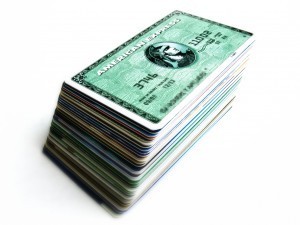Closing a Credit Card the Right Way
 Studies show that most Americans are satisfied with their credit cards. But despite being pleased with rates, rewards and customer service, a significant numbers of cards users still worry about the threat of credit card debt.
Studies show that most Americans are satisfied with their credit cards. But despite being pleased with rates, rewards and customer service, a significant numbers of cards users still worry about the threat of credit card debt.
There are roughly 610 million credit cards held by U.S. consumers and the average credit card debt per household with credit card debt totals $15,956. Even more, a recent study conducted by researchers at The Ohio State University found that millions of young Americans, people in their late 20s and early 30s, will be outlived by their credit card debt.
With that in mind, it’s no wonder why plenty of consumers might consider canceling their cards and if you’re thinking about ditching yours, you should do it in a way that doesn’t hurt your credit. For one,canceling cards can effectively reduce the amount of credit in your name, which has the potential to lower your credit score. The history of that account will also eventually get wiped from your credit history (not right away, but down the road). So, if it’s a substantially old account, this could also ding your score, as credit score calculators give you extra points for cards with lengthy, positive histories.
I tapped Ben Woolsey, director of marketing and consumer research for CreditCards.com, for his advice on how to make the process a bit easier and safer. Here’s a step-by-step guide to canceling a credit card:
Consider Your Debt to Credit Ratio
Your debt-to-credit ratio is equal to the total amount of revolving credit you’re using versus the total amount of credit in your name. It’s a significant variable in calculating your credit score (accounting for about 30% of your score, in fact); the lower the ratio the better for your score. For example, if you have two cards (Card A with $0 outstanding balance and $1,000 limit and Card B with a $5,000 outstanding balance and $14,000 limit), your debt to credit ratio is $5,000/$15,000 or 30%. Should you close Card A, your debt to credit ratio inches slightly higher to 36%. If you plan to apply for more credit or a loan in the near future and desire a low interest rate, note that this could do more damage to your credit reputation. Note: Consumers with the best credit scores in this country have debt-to-credit ratios of approximately 7%.
Consider the Age
The age of your account is key, according to Woolsey. “If the card you’re considering canceling is your oldest and you have many years of history on it, it’s best to pay it off then put it in a drawer just to maintain that length of credit because that’s a factor in your score,” he says. “Then use it once a year or so to keep it active.”
Prepare to Pay in Full
You can’t completely close a card until the balance is paid entirely. You’ll need to first pay off the credit card in full or, if you can find a balance transfer card with better terms, transfer the balance (watch out for transfer fees). Tip: If you don’t want any more charges added to the card until the balance is paid, you can contact the issuer and ask that the card be frozen until the balance is cleared and the account is closed.
Contact the Appropriate Representative
To begin the process of closing the account, call the customer service number found directly on your credit card, monthly statement or the issuer’s website. Inform the rep that you are canceling the card. Some companies will allow you to cancel without speaking to a representative but other may be less obliging. “Be prepared to have the customer service rep try and talk you out of closing your account. They will be very convincing, so if this is what you have decided, politely let them know you want the account closed immediately,” says Woolsey.
Send a Letter
If you need added insurance that the card is caput, write a short cancellation letter to the card issuer to request written confirmation of the account’s closure. “This is a must, and is to be done in conjunction with the phone call,” says Woolsey. The letter should include your name, address, phone number and account number and details from your phone call. Also, state that you want your credit report to reflect that the account was “closed at the consumer’s request.” It is very important to report that the account was closed in good standing and not the result of nonpayment or a settlement, as it could damage your credit.
Keep Excellent Records
Finally, as you go through the process of canceling your credit card, keep notes of your correspondence: to whom you spoke, what they said and when. It’ll come in handy if there are any discrepancies in the process.
Photo Courtesy, Andres Rueda.




